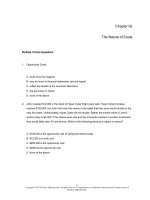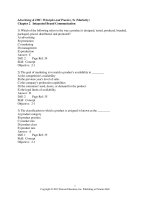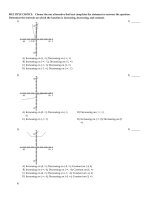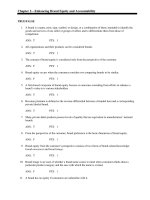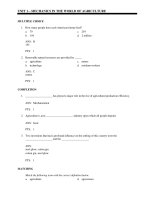Cognition theories and applications 9th edition reed test bank
Bạn đang xem bản rút gọn của tài liệu. Xem và tải ngay bản đầy đủ của tài liệu tại đây (146.04 KB, 8 trang )
Chapter 2-Pattern Recognition
MULTIPLE CHOICE
1. A method for distinguishing between real people and intelligent computer programs is to require both
to recognize
a. a face
c. a mangled word.
b. typed digits on a check.
d. a secret code.
ANS: C
DIF: Applied
REF: Describing Patterns
2. Which theory states that we compare patterns with each other and measure how much they overlap?
a. feature theory
c. template theory
b. Sperling's theory
d. Rumelhart's theory
ANS: C
DIF: Conceptual
REF: Describing Patterns
3. Template theories
a. are designed to explain our ability to read words faster than letters.
b. take an unanalyzed pattern and match it against stored alternative patterns.
c. analyze the specific features of a pattern.
d. specify how the features of a pattern are joined to each other.
ANS: B
DIF: Conceptual
REF: Describing Patterns
4. In an experiment by Phillips, subjects had to decide whether two checkerboard patterns were the same
or different. They could not make a template match
a. when the two patterns were in different locations on the screen.
b. after the visual information store decayed.
c. if the two patterns were separated by more than .5 seconds.
d. All of these
ANS: D
MSC: WWW
DIF: Factual
REF: Describing Patterns
5. The results of the Phillips (1974) study discussed in your text indicates that
a. the template model may describe events within the sensory store.
b. the feature model may describe events within the sensory store.
c. the template model may describe events within long term memory.
d. the feature model may describe events within long term memory.
ANS: A
DIF: Conceptual
REF: Describing Patterns
6. Which theory seems to best describe the contents of the sensory store?
a. template theory
c. feature theory
b. structural theory
d. geon theory
ANS: A
DIF: Conceptual
REF: Describing Patterns
7. The theory that describes patterns by listing their parts is
a. template theory.
c. structural theory.
b. feature theory.
d. prototype theory.
ANS: B
DIF: Conceptual
REF: Describing Patterns
8. If I were to describe my friend Bob by saying he has dark hair, blue eyes, and he's very tall, which
kind of theory would I be using?
a. template theory
c. structural theory
b. feature theory
d. geon theory
ANS: B
DIF: Conceptual
REF: Describing Patterns
9. A major difference between a feature theory and a template theory is
a. a feature theory specifies the relations between the features.
b. a template specifies the relations between the features.
c. a feature theory processes the input pattern as a single unit.
d. a template processes the input pattern as a single unit.
ANS: D
DIF: Conceptual
REF: Describing Patterns
10. Egeland taught kindergarten children to distinguish effectively between confusable letter pairs by
emphasizing
a. all the features of the letters.
c. the shared features.
b. the distinctive features.
d. none of the features.
ANS: B
DIF: Applied
REF: Describing Patterns
11. Emphasizing distinctive features when teaching young children to recognize letters
a. helps them to distinguish between letters afterwards and minimizes frustration due to
errors.
b. helps them to create a holistic template for letters.
c. helps them to understand the underlying principles of phonics and learn to read more
quickly.
d. is of no demonstrable benefit.
ANS: A
DIF: Applied
REF: Describing Patterns
12. The importance of distinctive features in pattern recognition is demonstrated by the finding that people
were
a. faster in identifying caricatures of faces than accurate line drawings of faces.
b. faster in identifying accurate line drawings than caricatures.
c. more often correct in identifying caricatures than accurate line drawings.
d. more often correct in identifying accurate line drawings than caricatures.
ANS: A
DIF: Applied
REF: Describing Patterns
13. According to Gibson's feature theory, features should remain unchanged despite changes in
a. brightness.
c. perspective.
b. size.
d. All of these
ANS: D
DIF: Conceptual
REF: Describing Patterns
14. A set of proposed features is usually evaluated by
a. asking people whether it looks reasonable.
b. determining whether it can account for perceptual confusions.
c. observing how people draw patterns.
d. All of these
ANS: B
MSC: WWW
DIF: Factual
REF: Describing Patterns
15. Structural theories of pattern recognition
a. deny the existence of features.
b. are extensions of feature theories.
c. assume that a pattern can be described by listing its features.
d. ignore the relationship among features.
ANS: B
DIF: Conceptual
REF: Describing Patterns
16. Structural theories have the advantage over feature theories in that
a. they specify spatial relationships.
b. they specify more features.
c. they make it easier to predict perceptual confusions.
d. they can accommodate Phillips' results on matching checkerboard patterns.
ANS: A
DIF: Conceptual
REF: Describing Patterns
17. Biederman’s component model is an example of
a. a feature model in which all the features are characterized.
b. a template model in which there are only a limited number of templates.
c. a structural model in which a limited number of components can be used to build many
different objects.
d. None of these
ANS: C
DIF: Conceptual
REF: Describing Patterns
18. In an experiment by Biederman, the recognition of objects was more difficult when lines were deleted
at
a. midsegments, supporting a template theory.
b. midsegments, supporting a structural theory.
c. vertices, supporting a template theory.
d. vertices, supporting a structural theory.
ANS: D
DIF: Factual
REF: Describing Patterns
19. Discriminating between different variations of the same geon was easier than discriminating between
different geons for
a. college students in the United States.
c. both a and b.
b. the Himba in a remote region of Namibia. d. neither a nor b.
ANS: D
DIF: Factual
REF: Describing Patterns
20. The skeleton structure of animals can best be described by a
a. template theory.
c. structural theory.
b. feature theory.
d. None of these
ANS: C
DIF: Conceptual
REF: Describing Patterns
21. Which of the following models does not belong?
a. filter
c. structural
b. feature
d. template
ANS: A
DIF: Conceptual
REF: Describing Patterns
22. The duration of the visual sensory store is approximately
a. 2.5 msec.
c. 250 msec.
b. 25 msec.
d. 2500 msec.
ANS: C
DIF: Factual
REF: Information-Processing Stages
23. How does the partial report technique differ from the whole-report technique?
a. The partial report technique presents information for only a very brief time.
b. The partial report technique presents each line individually.
c. The partial report technique requires the subject to respond with all recalled information.
d. The partial report technique requires the subject to respond with only certain items.
ANS: D
DIF: Factual
REF: Information-Processing Stages
24. The purpose of Sperling's partial report technique was to distinguish
a. auditory encoding from visual encoding.
b. sequential scanning from parallel scanning.
c. perceptual limitations from memory limitations.
d. short-term memory from long-term memory.
ANS: C
DIF: Conceptual
REF: Information-Processing Stages
25. One of the interesting results of Sperling’s partial-report technique results was that
a. there was never a difference between the partial-report and whole-report findings.
b. so long as subjects responded within 5 seconds, there was no difference between the
partial-report and whole-report findings.
c. after a one second delay, the results were the same as those obtained by the whole-report
technique.
d. None of these
ANS: C
DIF: Factual
REF: Information-Processing Stages
26. Serial processing is _____ while parallel processing is _____.
a. one at a time; multi-tasking
c. geons; features
b. Rumelhart; Sperling
d. All of the above
ANS: A
DIF: Conceptual
REF: Information-Processing Stages
27. The decay rate of the visual information store depends on all of the following except
a. occurrence of a second exposure.
c. intensity of the stimulus.
b. contrast of the stimulus.
d. rehearsal.
ANS: D
DIF: Factual
REF: Information-Processing Stages
28. Sperling proposed that people use the auditory information store to rehearse the names of patterns. The
auditory information store is a part of
a. the sensory store.
c. short-term memory.
b. the scan component.
d. long-term memory.
ANS: C
MSC: WWW
DIF: Factual
REF: Information-Processing Stages
29. What was the major revision in Sperling's 1967 model for the visual report task?
a. the change from sequential scanning to parallel scanning
b. the change from parallel scanning to sequential scanning
c. the addition of the visual information store
d. the addition of the auditory information store
ANS: A
DIF: Conceptual
REF: Information-Processing Stages
30. Which of the following is true for Rumelhart’s model of pattern recognition?
a. It is a mathematical model.
b. Recognition is influenced by the number of items in the display.
c. Recognition is influenced by the clarity of information.
d. All of these
ANS: D
DIF: Conceptual
REF: Information-Processing Stages
31. According to Rumelhart's model, people recognize items in a display by using
a. a parallel scan and feature recognition.
c. a serial scan and feature recognition.
b. a parallel scan and template matching.
d. a serial scan and template matching.
ANS: A
DIF: Conceptual
REF: Information-Processing Stages
32. According to Rumelhart's model, people do better in the partial report procedure than in the whole
report procedure because
a. they can use the visual information store to read off letters in the cued row.
b. the clarity of the visual information store increases over time.
c. they can often correctly guess which row will be cued.
d. they have less to remember.
ANS: A
DIF: Conceptual
REF: Information-Processing Stages
33. Imagine that you view a brief flash of letters. In which series will it be easiest to judge whether the
letter C or M was the third letter?
a. AFCE
c. --Cb. FACE
d. All are equal
ANS: B
DIF: Applied
REF: Word Recognition
34. The 'word superiority effect' refers to the finding that it is easier to recognize a letter in a word than
a. a letter by itself.
c. Both a and b
b. a letter in a non-word.
d. Neither a nor b
ANS: C
DIF: Factual
REF: Word Recognition
35. The interactive activation model of word recognition proposes that information about the letters in a
word comes from
a. the feature level.
c. Both a and b
b. the word level.
d. Neither a nor b
ANS: C
DIF: Conceptual
REF: Word Recognition
36. An important effect of the interactive activation model proposed by Rumelhart and McClelland is that
it stimulated interest in
a. feature models.
c. template models.
b. neural network models.
d. structural models.
ANS: B
MSC: WWW
DIF: Factual
REF: Word Recognition
37. Neural network models have been most widely used to model
a. pattern recognition.
c. problem solving.
b. STM.
d. text comprehension.
ANS: A
DIF: Factual
REF: Word Recognition
38. Neural network models include all except which of the following?
a. processing units called nodes
c. states of activation
b. connections among nodes
d. strictly serial processing
ANS: D
DIF: Conceptual
REF: Word Recognition
39. Neural network models consist of nodes that are
a. independent of each other.
b. connected to each other by excitatory connections.
c. connected to each other by inhibitory connections.
d. connected to each other by excitatory and inhibitory connections.
ANS: D
DIF: Conceptual
REF: Word Recognition
40. Learning in neural network models occurs by
a. creating new nodes.
b. creating new connections.
ANS: C
MSC: WWW
DIF: Conceptual
c. changing weights of connections.
d. eliminating excess nodes.
REF: Word Recognition
TRUE/FALSE
1. Computers are superior to humans in their ability to recognize patterns.
ANS: F
DIF: Applied
REF: Introduction
2. Template matches can occur in the sensory store.
ANS: T
DIF: Conceptual
REF: Describing Patterns
3. A distinctive feature is one that is present among all exemplars of a given category and helps define
that category.
ANS: F
DIF: Factual
REF: Describing Patterns
4. A geon is essentially a three-dimensional feature.
ANS: T
DIF: Conceptual
REF: Describing Patterns
5. Sperling modified his original information-processing model by changing a parallel scan to a serial
scan.
ANS: F
DIF: Conceptual
REF: Information-Processing Stages
6. Detection paradigms are those in which one has to specify which of two possible target patterns is
present in a display.
ANS: T
DIF: Factual
REF: Information-Processing Stages
7. Rumelhart’s recognition model is influenced by the number of items in a display.
ANS: T
DIF: Conceptual
REF: Information-Processing Stages
8. The term superiority effect indicates that accuracy in recognizing a letter is higher when the letter
appears alone than when it is part of a word.
ANS: F
DIF: Factual
REF: Word Recognition
9. Neural network models can have both inhibitory and excitatory connections.
ANS: T
DIF: Conceptual
REF: Word Recognition
10. Neural network models can have connections that are only on or off.
ANS: F
DIF: Conceptual
REF: Word Recognition
ESSAY
1. Why was Sperling’s partial report technique an innovation in research methodology, and why was it so
important?
ANS:
Answer not provided.
2. There are three major perspectives on pattern recognition: template, feature, and structural models.
Explain the strengths and weakness of each model.
ANS:
Answer not provided.
3. Of the major theoretical perspectives of pattern recognition which do you prefer, and why?
ANS:
Answer not provided.
4. Describe the partial-report technique. What were the major findings from these studies?
ANS:
Answer not provided.
5. Compare and contrast Sperling’s model of information processing with Rumelhart’s.
ANS:
Answer not provided.
6. What is the word superiority effect? Describe the model discussed in your text to explain this effect.
ANS:
Answer not provided.
7. What are neural network models? What are the components of a neural network?
ANS:
Answer not provided.
8. Explain how perpetual learning can be facilitated by the highlighting of distinctive features. What
benefits result from this method?
ANS:
Not provided.
9. Describe the impact of Biederman's work on structural theories. How did it build upon the previous
work of others?
ANS:
Not provided.
10. Why do people have difficulty recognizing faces of other races?
ANS:
Not provided.
